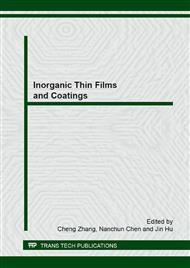p.28
p.32
p.36
p.42
p.46
p.52
p.58
p.63
p.67
TiC-TiB2 Coating on Ti-6Al-4V Alloy Substrate in Graded Composition Achieved by Fusion Bonding and Atomic Interdiffusion under Combustion Synthesis in High-Gravity Field
Abstract:
Based on fusion bonding of liquid TiC-TiB2 ceramic film and molten Ti-6Al-4V substrate to induce the surface alloying of Ti-6Al-4V substrate, the TiC-TiB2 ceramic coating on Ti-6Al-4V substrate was achieved in graded composition by combustion synthesis in high-gravity field. XRD, FESEM and EDS results showed that TiC-TiB2 ceramic coating was composed of fine TiB2 platelets, TiC irregular grains, Cr metallic phase and a few Al2O3 inclusions. The mechanical properties showed that the relative density, microhardness and fracture toughness of TiC-TiB2 ceramic coating reached 98.5%, 25.8 ± 3.5 GPa and 16.5 ± 2.5 MPa • m0.5, respectively. The fusion-bonding area and heat-affected zone of Ti alloy were obviously observed between the ceramic coating and Ti alloy substrate, and within the fusion bonding area a number of ultralfine TiB platelets and fine Ti-enriched carbides were embedded in the matrix of α’-Ti martensite, whereas at the heat-affected zone of Ti-6A1-4V substrate some C, B atoms were also detected. As a coupled result of fusion bonding and inter-diffusion between liquid ceramic film and molten Ti alloy substrate, followed by TiB2-Ti peritectic reaction and subsequent eutectic reaction in TiC-TiB-Ti ternary system, the ceramic coating of TiC-TiB2 on Ti-6Al4V substrate was achieved in continuously-graded composition, presenting the transitional change in microhardness from the ceramic coating to Ti alloy substrate with high shear strength of 450 ± 35 MPa between the coating and the substrate.
Info:
Periodical:
Pages:
46-51
Citation:
Online since:
January 2013
Authors:
Price:
Сopyright:
© 2013 Trans Tech Publications Ltd. All Rights Reserved
Share:
Citation:


